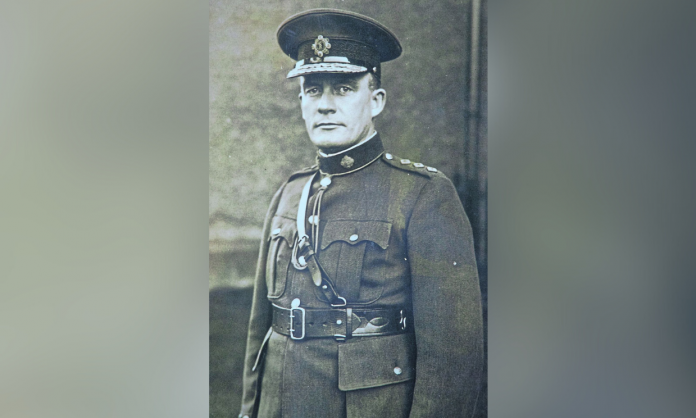By James Reddiough
Eamon Broy was born in Ballinure, Co Kildare on the 22 December, 1887 and he came from a farming background. He joined the RIC in August 1910 and the DMP in January 1911 where he was attached to E Division. He became a detective in 1915. Even though he joined the DMP he was not particularly loyal to the Crown and believed in Home Rule. He joined the DMP for its excellent athletic facilities and was a member of the G Division of the Dublin Metropolitan Police or DMP for short.
After the 1916 Rising he believed that independence could only come about through physical force and he began supplying information to the IRA and IRB. In March 1917 he was a clerk with the G Division of the DMP, meaning that he had access to confidential information that would be of immense benefit to Collins in the intelligence war. He made contact with the volunteers, one Harry O’Hanrahan who was an agent for Michael Collin and passed on confidential documents and codes from British Intelligence to the volunteers.
March 1918 came along and there was a conscription crisis in April 1918 and the volunteers organised a GHQ plan to direct the campaign against conscription. Broy would be central to this campaign. Broy’s information became increasingly important to the volunteers and they were fore – warned of arrests of leading figures in Sinn Fein and the IRA as the months went by.
The best example of this was the German plot in May 1918 when leading members of Sinn Fein, including Eamon de Valera were to be arrested for conspiring with Germany – Broy passed the list onto O’Hanrahan and sure enough despite advice from Collins the Executive of Sinn Fein, apart from Collins and Harry Boland, were lifted and interned.
Collins first met Ned Broy in April 1919 at No. 5 Cabra Road when Broy succeeded in getting Collins access to the files of the British Secret Service in Great Brunswick Street DMP station, and Collins was able to take the upper hand in the intelligence war from then on, leading to the targeting of DMP and British intelligence officers, with Bloody Sunday being the most notable example.
But then there was a change in fortunes when some typed documents were discovered in the flat of Eileen McGrane, one of Collins’ secretaries and Broy was arrested in December 1920, and interned in Arbour Hill Prison and it was rumoured that he was to be executed, but thanks to some work by Collins the death sentence was never passed. Broy was released in August 1921 under the terms of the Truce. Broy went as part of the delegation to debate the Treaty in October 1921. In the new Free State, he held rank in the National Army as O/C of the Air Corps, and he was Colonel Ned Broy for the rest of the Civil War.
He had a distinguished career later in the newly formed Garda Síochána and was superintendent, and later in February 1933 he succeeded Eoin O’Duffy as Commissioner of the Guards; a post he held until his retirement in August 1938. The S Guard or Special Branch commonly known as the Broy Harriers after their founder were established in 1934, but they were quickly disbanded in controversy in 1935. As stated earlier Broy’s garda career ended with his retirement in August 1938.
Ned Broy married and he had two children. He was a multi-linguist able to speak Irish, French and German and he attended many International police conferences representing Ireland. He held many posts in the Olympic Council of Ireland and was President of the Irish Olympic Council of Ireland from 1938 to 1950 and earlier in the 1920’s and 1930’s he went to the Olympic games at various locations.
Eamon Ned Broy died in his Dublin home on the 22 January 1972 after a long and distinguished career to the Irish State. It is only fitting to remember and honour him after 100 years since the Truce and Treaty, for the role that he played in attaining independence for this country.








